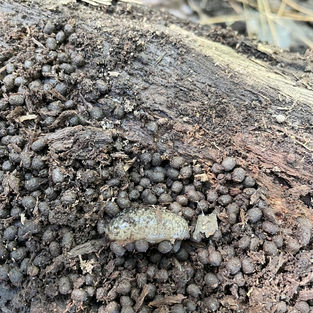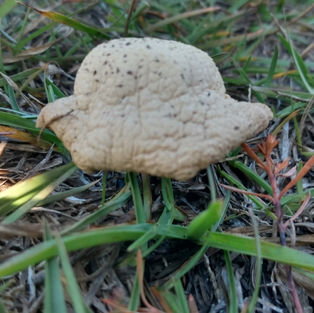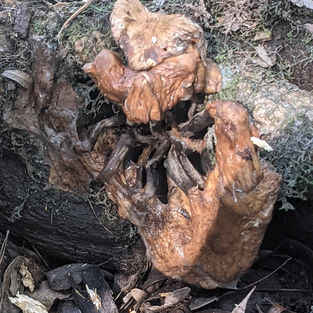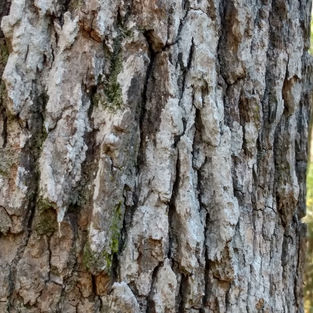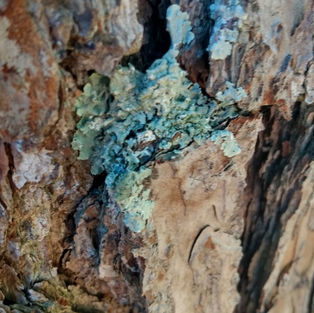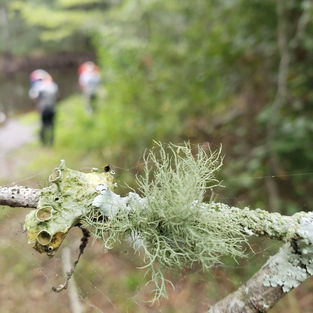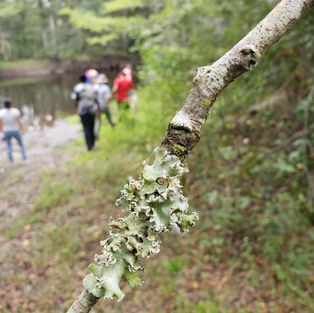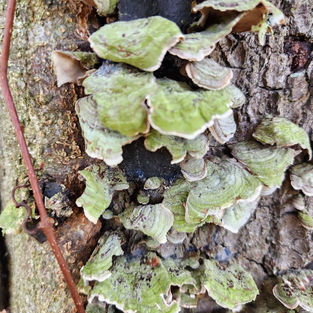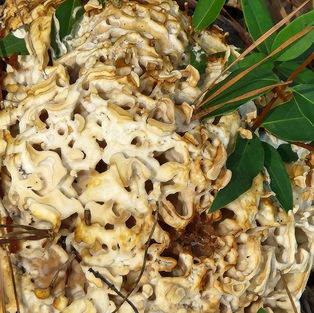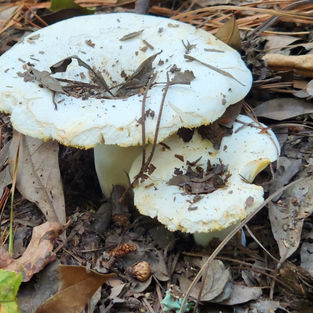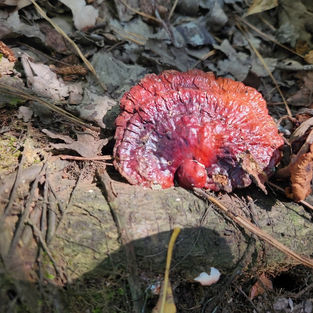Fungi




False-Turkey Tail
Sterum ostrea



What are fungi?
Fungi are not plants. In fact, they share more traits with animals than they do with plants (Carris, 2012). Some examples of different types of fungi are mushrooms, puffballs, and turkey tail. Fungi are eukaryotic heterotrophs that get their nutrients externally through their cell walls, which are made of chitin (same materials in the outer coverings of most insects). The main body of the actual fungus is hidden inside the soil. Fungi have hyphae, which are filaments in a tubular formation that form a large structure. It’s called the mycelium, and its web-like filaments can cover either small or large amounts of space depending on the species (Britannica, c2021). Fungal maturity causes the fungus to produce spores for dispersal, and new fungi grow from germinating spores (Britannica, c2021).
Why are they important?
Fungi can act as the decomposers of the natural world responsible for consuming organic materials, which in turn enriches the soil (Britannica, c2021). Fungi also help in the cycling of nutrients back into the environment. Other capabilities of fungi that make these species beneficial to people include being consumers of insects and by some species being pathogenic to soil nematodes that cause disease (Ingham, c2021). So, they can help in agricultural practices while being used in other facets of human life such as for consumptive uses for both food and medical purposes (Ingham, c2021). Some examples of fungi used as food include truffles, portobellos, and shiitakes. Fungi used for medicine are penicillin, lovastatin, and cyclosporine (Crampton 2021).
Where do fungi live and how abundant are fungi?
While some fungi can be easily seen with the naked eye, other fungi require a microscope to be recognized on living or dead organic matter (Ahmadjian et al. 2022). Fungi can reside in both aquatic (freshwater or marine) and in terrestrial environments. Most fungi thrive in soil with rich organic matter, and every tropical and temperate location has soil that is sufficient in moisture for fungi to grow. Very few fungal species are found in the Arctic regions, however they are more frequently found coexisting with algae as lichens. It is predicted that there are over 2 million species of fungi, but only 144,000 species have been identified (Ahmadjian et al. 2022).
Lichen
Lichens are often misinterpreted as a single life form but are in fact a symbiotic relationship between one or two species of fungus and an alga (Alexopoulos et al. 2022). These algae are called phycobionts and are woven into filaments in the fungi called mycobionts. There are around 15 species of single-celled algae that have been found in association with lichens. Some of these include members of Nostoc, Calothrix, and Gloeocapsa. Although earlier scientific names have been given to lichens, these names are now considered only for the fungus as their dual nature was found only after lichen names were given. Although lichen evolution is a mystery as of right now, recent research has shown that the ability to form lichens can possibly be spread between different fungi and algae, creating new types of lichens. Due to their dual nature and the questions around their evolution, lichens are lacking their formal status in the taxonomy. According to Alexopoulos et al. (2022), there are about 15,000 different types of lichens. Lichens are known to often have a button-shaped fruit known as an apothecium. They also have a thallus that has several growth forms. These forms can be crustose (which resembles a crust on the surface of an object), foliose (which resembles leaves), and fruticose (which forms stalks in order to utilize the water vapor prevalent in the humidity).
Almond Mushrooms (Agaricus subrufescens)
The almondy flavor of Agaricus subrufescens is what earned it the common name “almond mushroom” (Chugh et al., 2022). It generates a broad range of bioactive substances capable of treating many illnesses (Chugh et al., 2022). Included amongst its many therapeutic benefits are antiviral and antibacterial properties, tumor growth prevention, antiallergy properties, and it also acts as a stimulant for the immune system. These benefits are obtained by extracting necessary compounds from the fungus and incorporating them into medicine, as seen in alternative medical practices widely used in regions of Asia and Brazil (Jamie 2022). Apart from its medicinal purposes, almond mushrooms are cultivated across the United States to be used in several dishes for their sweet taste (Fungi Ally 2022).
Trametes versicolor, Turkey Tail
Highly recognizable by its zonate, often vivid coloration from which it received its name, turkey tail is among the most well known and researched bracket fungi (Chugh et al. 2022). This polypore, located in bundles growing from decaying hardwood trees, is considered medicinally significant, best prepared powdered or liquified as an extract (Chugh et al. 2022). Among the reported health benefits is (primarily) immune support, followed by gut probiotics and antioxidants (Myszko 2021). Turkey Tail is edible and can be eaten, though harvesting wild mushrooms can be boiled in tea or added to soup. Sharing Trametes versicolor’s propensity for temperate climates is its sister species Stereum ostrea, false turkey tail, another shelf fungus of similar appearance with no edibility or medical application (The sophisticated Caveman 2021).
References:
Ahmadjian, Vernon, David Moore, and Constantine John Alexopoulos.2022. "fungus." Encyclopedia Britannica. https://www.britannica.com/science/fungus
Alexopoulos, C. John , David Moore, and Vernon Ahmadjian. 2022. "Lichens." Encyclopedia Britannica, August 16, 2022. https://www.britannica.com/science/fungus/Lichens
Britannica, c2021, Fungus, https://www.britannica.com/science/fungus/Form-and-function-of-fungi. Accessed November 17, 2021.
Carris, Lori M., Christopher R. Little, and Carol M. Stiles, 2012, Introduction to Fungi. https://www.apsnet.org/edcenter/disandpath/fungalasco/intro/Pages/IntroFungi.aspx .
Chugh RM, Mittal P, MP N, Arora T, Bhattacharya T, Chopra H, Cavalu S and Gautam RK. 2022. “Fungal Mushrooms: A Natural Compound with Therapeutic Applications.” Front. Pharmacol. 13:925387. doi: 10.3389/fphar.2022.925387 https://www.frontiersin.org/articles/10.3389/fphar.2022.925387/ful
Crampton, Linda, 2021 Penicillin, Lovastatin, and Cyclosporine: Medicines from Fungi https://owlcation.com/stem/Medications-From-Molds-Fungi-and-Health
Fungi Ally. 2022. Sturk, Chris. 2021. “The Incredible, Edible Almond Agaricus Mushroom (Agaricus Subrufescens).” https://www.fungially.com/blogs/growing-mushrooms/the-incredible-edible-almond-agaricus-mushroom-agaricus-subrufescens
Ingham, Elaine R., c2021, Soil Fungi, USDA. https://www.nrcs.usda.gov/wps/portal/nrcs/detailfull/soils/health/biology/?cid=nrcs142p2_053864
Jamie. 2022. “Almond Agaricus - Identification, Growth & Cultivation Guide.” WhyFarmIt.com. June 3. https://whyfarmit.com/almond-agaricus/
Myszko, Amy. 2021. “Turkey Tail Mushroom Guide: Health Benefits and Ways to Use This Superfood.” Om Mushroom Superfood. Om Mushroom Superfood, 2021. https://ommushrooms.com/blogs/blog/turkey-tail-mushroom-m2
The Sophisticated Caveman. 2021 “Turkey Tail Mushrooms.” https://www.thesophisticatedcaveman.com/turkey-tail-mushrooms/



